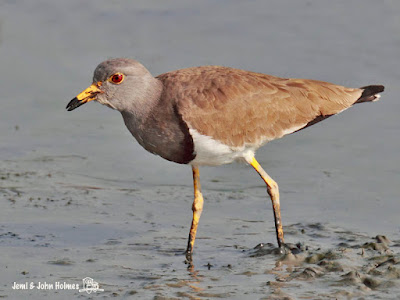I remember staying somewhere on my travels where a stroll uphill and through some woods was recommended as a “Wilderness Experience” – as if this was a good thing.
In reality, though, the “Wilderness Experience” was but a short interlude between my comfortable bed and a sumptious breakfast buffet.
I think what they meant was that the air was fresh and the views fine. And that was true enough.
Birding in Hong Kong takes one to some picturesque places, but often one has to ignore the hand of man when appreciating good birds.
The presence of Grey-headed Lapwings along the Kam Tin River is a case in point.
Three large flyovers don't seem to bother them..... but, as their traditional Buffalo Field habitat near Shui Tau Tsuen has been trashed, perhaps they have no choice.
Grey-headed Lapwing habitat in 2011
Grey-headed Lapwings (Vanellus cinereus)
A "Globally Near-threatened" species (Birdlife International), a flock of about a dozen returns to Hong Kong every winter.
But for how much longer ?






Odd to see them on mudflats, they are paddyfield birds here always. But then, as you point out, beggars can't be choosers!
ReplyDeleteReally nice shots of the lapwings, and I just noticed that it's a globally near-threatened species! I see these birds every winter in Thailand in a good number, but they're not as approachable as the ones in your photos. As Digdeep said, they're paddyfield birds in Thailand too. The habitat in your photo looks a bit odd to me...
ReplyDeleteHi David and Ayuwat,
ReplyDeleteYes, being confined to the man-made water course - and roosting on the banks at high tide - is a very marginal habitat for Grey-headed Lapwings, but I guess they've got nowhere else to go. There are really no large, damp unmanaged grasslands left here. They seem to find just enough to eat and can remain relatively undisturbed.
John
They are just back for the winter now. While cycling we saw them at exactly the same spot and then I had to google them and landed on your blog. Altogether we saw around 10. Beautiful birds!
ReplyDeleteI haven't seen them yet this winter... but now I know where to start looking, thanks !
ReplyDelete